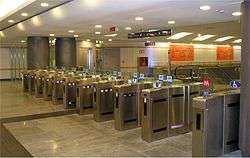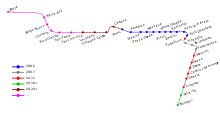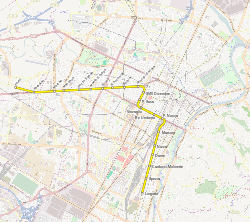Turin Metro
 | |||
 | |||
| Overview | |||
|---|---|---|---|
| Native name | Metropolitana di Torino | ||
| Locale | Turin, Piedmont, Italy | ||
| Transit type | Rapid transit | ||
| Number of lines | 1 | ||
| Number of stations | 21[1] | ||
| Annual ridership | 35,432,000 (2014)[2] | ||
| Operation | |||
| Began operation | 4 February 2006 | ||
| Operator(s) | Gruppo Torinese Trasporti (GTT) | ||
| Number of vehicles | 58 (2009)[3][Note 1] | ||
| Train length | 52 m (171 ft) | ||
| Headway | 2 minutes | ||
| Technical | |||
| System length | 13.2 km (8.2 mi)[1] | ||
| Average speed | 33 km/h (21 mph)[1] | ||
| Top speed | 80 km/h (50 mph)[1] | ||
| |||
The Turin Metro (Italian: Metropolitana di Torino) is the modern VAL metro system serving Turin. It is operated by Gruppo Torinese Trasporti (GTT), a public company controlled by the municipality of Turin. The system comprises one 13.2-kilometre (8.2 mi) line with 21 stations connecting Fermi station in Collegno with the Lingotto multifunctional centre in Turin.[1]
History
The history of metro in Turin begins in 1930s, when the first project of an underground railway was put forward. However, only a part of the first underground tunnel was built, and the actual project was put aside. Nowadays, the tunnel is part of an underground parking system.
A new company committed to the development of a metro system in Turin was founded in 1960s. Several projects and feasibility studies were made for a 7 km underground line under the city centre and then for a line connecting FIAT factories to surrounding neighborhoods, but eventually all the proposals were rejected.
In the mid-1980s a new proposal for a system of 5 fast tram lines at-grade was approved. However, only the planned line 3 was built following the original project, while the others eventually were built either as regular tram lines, with no dedicated lane, or as bus lines.
A new project was approved in 1995 for a line running from Campo Volo on the west border of the city to Porta Nuova, the main railway station in Turin. The project was put in hold due to lack of funds.
The project for the underground line was resumed in April 1999 with a longer route to Lingotto based on the VAL system. Works on the line began on 19 December 2000, part of the works for the Turin 2006 Winter Olympics. The first section from Fermi to XVIII Dicembre was opened on 4 February 2006, while the second section on the south to Porta Nuova opened on 5 October 2007. Porta Susa station opened later on 9 September 2011. The last part of the line on the south to Lingotto was inaugurated on 6 March 2011.[4]
Timeline
| Section | Date | Route |
|---|---|---|
| 1 | 4 February 2006 | Fermi - XVIII Dicembre |
| 2 | 5 October 2007 | XVIII Dicembre - Porta Nuova |
| 3 | 6 March 2011 | Porta Nuova - Lingotto |
Network
| Line | Terminals | Opened | Newest extension | Length | Stations |
|---|---|---|---|---|---|
| Line 1 | Fermi - Lingotto | 4 February 2006[1] | 6 March 2011[1] | 13.2 km (8.2 mi)[1] | 21[1] |
Service
Ticketing
The single journey ticket costed €1.70 and was valid also outside of the metro for unlimited trips on other public transport in the city for 90 minutes. From May 2018 the single journey ticket costs €1.70 and it includes the urban line and the suburban line for 100 minutes. Moreover, any form of urban transport season ticket is valid also for the metro system.[5]
Opening hours
Turin metro starts operating at 5:30 from Monday to Saturday and at 7:00 on Sundays. It closes at 22:00 on Mondays, at 00:30 from Tuesday to Thursday, at 1:30 on Friday and Saturday and at 1:00 on Sundays.[6]
Plans
| Turin Metro - Line 1 |
|---|
Line 1

Two additional stations, reaching the Southern boundary of the city, are currently under construction. These stations will be known as Italia '61, serving the new Piedmont Region Headquarters, and Bengasi, named for the piazza under which it will be located. Recent estimates suggest this southern extension will be completed not before the end of 2018.[7]
A further Western extension is planned to reach the boundaries of Collegno and the city of Rivoli. In December 2017, the city approved the first stage of the project, valued at €123.7 million, to construct two already named stations: Certosa, which will interchange with the central railway station of the city of Collegno, and Collegno Centro, serving its central market area. An additional two stations, including one in the Leumann Village neighbourhood and another in the Cascine Vica district of Rivoli, are expected to be built at a later stage.[8]
Line 2
On August 30, 2017, a contract to create the preliminary design for a second line was awarded to Systra, a French conglomerate.[9] The line will connect South-Western suburbs of the city (Orbassano and Beinasco) with the northern district of Barriera di Milano. The first 26 stations had already been defined, starting from Mirafiori Sud district to Barriera di Milano, crossing the Line 1 at Porta Nuova station and serving key points as Politecnico di Torino University and Piazza Castello, one of the major central squares of the city.
Part of the Southern track will be elevated to reduce building costs (starting from Piazza Cattaneo to Cimitero Sud). On Northern side, from Vanchiglia to Rebaudengo, it will follow an old (currently abandoned) railway track, which was used to connect the old and abandoned scalo Vanchiglia to the main Turin railway.
Preliminary analysis conducted by Systra in the Spring of 2018 resulted in some changes to this original alignment. The following June, public consultations were announced and the new alignment, with the list of 23 planned stations was published on the city's website.[10]
| List of planned stations of the Turin Metro Line 2 |
|---|
|
In the future, a 4 station extension could cover suburbs of Beinasco and Orbassano to reach terminus Pasta di Rivalta in the city of Rivalta di Torino.
Potential Line 3
The current mayor of Turin, Chiara Appendino, publicly supports the idea of a third line for the city's Metro system.[11] Campaign literature, published on the then candidate's website during the Turin municipal election, 2016, show Line 3 using tracks that formally served the Ferrovia Torino-Ceres railway.[12] Potential stations would serve the community of Venaria Reale, the Juventus Stadium and Turin International Airport. Since the election, Deputy Mayor and Chief of Urban Planning Guido Montanari has expressed interest in readapting the Torino-Ceres line to be part of the city's Metro network.[13]
Rolling Stock
See also
Notes
- ↑ Before the extension to Lingotto.
References
- 1 2 3 4 5 6 7 8 9 "La Linea 1 di Metropolitana" [Metro Line 1] (PDF) (in Italian). Citta' di Torino. Retrieved 2014-05-24.
- ↑ http://www.lastampa.it/2015/12/01/cronaca/un-milione-di-passeggeri-in-pi-in-metro-arrivano-i-vigilantes-tDHNU8V3PAQ2MOqby4PWtO/pagina.html?zanpid=2106700083273040896
- ↑ "Servizi" (PDF). GTT. Archived from the original (PDF) on 12 August 2011. Retrieved 25 September 2011.
- ↑ "Metropolitana Torino fino al Lingotto, inaugurazione 6 marzo con tratte gratuite e feste di via". Eco di Torino. Retrieved 26 February 2011.
- ↑ "URBAN AND SUBURBAN TRANSPORT FARES". GTT Torino. Retrieved 8 December 2017.
- ↑ "Gli orari". GTT Torino. Archived from the original on 20 April 2013. Retrieved 16 April 2013.
- ↑ "Lingotto-Bengasi, slitta il prolungamento? Il M5S smentisce: La metro entro il 2018". Diario di Torino. Retrieved December 6, 2017.
- ↑ "Metro dopo metro la linea 1 vedrà il completamento!". Mobilita Torino. Retrieved December 6, 2017.
- ↑ "Nuovo step per la linea 2 della metro di Torino". TorinOggi.it. Retrieved 18 November 2017.
- ↑ "M2TO Progetto Premliminare della Linea 2" (PDF). Citta di Torino. Retrieved 16 July 2018.
- ↑ "Elezioni, Appendino vuole tram e bus gratis su alcuni percorsi". La Repubblica. Retrieved 8 December 2017.
- ↑ "Program for Torino 2016". Chiara Appendino. Retrieved 8 December 2017.
- ↑ "Montanari:La linea 2 è soltanto un bluff: meglio ripensarla". La Stampa. Retrieved 8 December 2017.
External links
| Wikimedia Commons has media related to Metrotorino. |
- Turin Metro Map on Google earth with geolocation
- GTT – official website (in Italian)
- Line 2 Public Consultations Website (in Italian)
- Turin Metro Infrastructure
- Metrotorino at UrbanRail.Net
- Site with information and picture of Metrotorino (in Italian)
- Metrotorino at metros.hu (in Hungarian)
- Photos
- Turin Metro Map (in English)

